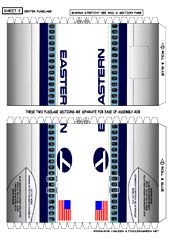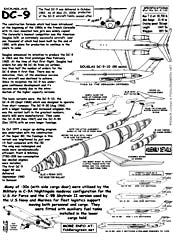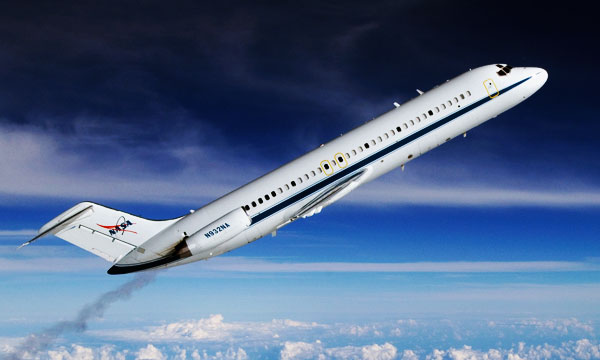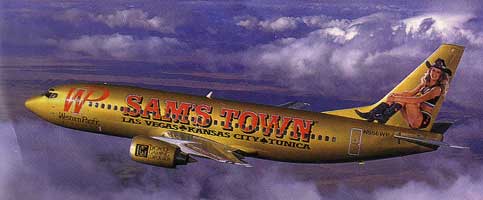



Douglas DC-9 Airliner - $$12.95
Rob Carleen^s first airliner. Tons of extra effort has been spent on the BW files so you can create new airline versions easily and beautifully. There^s a special page of additional fuselage sections that you can print and add to make your DC-9 the Super Model 80 with a fuselage of about 28 inches long! Four airline versions included as of 7/09
Douglas DC-9 Airliner


 The construction formula which had been introduced at
the beginning of the 1950s in the French Caravelle, with its rear-mounted
twin jets, was widely copied by all manufacturers. The Caravelle's
most serious competitor was the American Douglas DC- 9 - an extremely
successful aircraft.
The construction formula which had been introduced at
the beginning of the 1950s in the French Caravelle, with its rear-mounted
twin jets, was widely copied by all manufacturers. The Caravelle's
most serious competitor was the American Douglas DC- 9 - an extremely
successful aircraft.
Douglas announced its intention to produce the DC-9 in 1963, and the first prototype flew on February 25, 1965. At the time of that first flight, Douglas had orders for only 58 DC-9s from six airlines, less than half the number of orders for the DC-8 when it first flew. There was no indication then of the enormous success this aircraft was destined to achieve.
Thanks Chip! Another great model! Bob D...
Thank you. Oh Boy, a modern airliner. If you are looking at the 747, DC-8, and 727 they sure would be neat in Flying Tiger Line colors...hint...hint. Thanks again folks, Bob Penikas
Great to have he DC-9 as a model now! Many other icons of the commercial aviation may follow, I hope, and not the least the venerable B707 (at the E-3A AWACS while you're at it) may be next? One thing; why do you show Santa splashed on an aircraft nose with the DC-9? Nice paint job, but it is on the nose of a Boeing 737, and on a DC-9.
Thanks and kind regards, Eric
ans:Eric ,I was wondering who would be the first to notice that :-)) I've had that image kickin' around for a year of so, and just had to use it. We'll see how the DC-9 sells before going any further with airliners. Thanks for your email !! chip
What a hoot!!! (re: giant version) This would make that plane 7 times the size of a Reagan Class Carrier, and capable of handling comfortably about 60,000 passengers. I am sure Howard Hughes would turn over in his grave upon hearing about this monster. Not only would his title of "King Of the Hill For Air Titans" be compromised, indeed he would not even be able to climb that hill...Loved it..W.Yeager
Your new DC-9 model looked great till I started putting
it together. There's nobody more accurate than I am in cutting
out parts. My tolerance is less than 0.5mm, wearing magnifying
glasses. But I can't get the nose sections to fit together.
The diameters of the male edges (with tabs) are too large
to fit into the female edges (without tabs). I tried twice
to get the two sections behind the nose piece to fit. I
tried with the regular tabs and with internal tabs, but
no luck. If I reduce the larger diameter to fit, then that
creates a chain reaction so I would have to do that to all
of the following sections. I'm using the same 60lb card
stock I've always used. I've also had the same problem occasionally
with cylindrical and conical sections of some other models
in the past. I wonder if any other builders are having the
same problem.
Your loyal fan, Bill
We'll see, Bill..chip
Chip, I wrote you recently, (concerned) about the DC-9
nose pieces not fitting together properly. I had started
at the nose and tried to work toward the back. Then I started
over, going from the largest middle section forward, and
the sections went together pretty well. For some reason,
for this particular model, working toward the front worked
better than working toward the back
The plane looks very good. I sprayed it with Krylon clear
glaze to give it a shiny look. I'm doing the Norge airship
now.
Bill, Dayton OH
Douglas DC-9

 When the DC-9 was first flown in 1965, it was as
an 80-passenger short-haul jet. McDonnell Douglas always intended
to stretch the plane, though not so far as the current model,
the Super 80, which carries 155 passengers. Late 1960 model DC9s,
carrying just over 100 passengers, were among the noisiest in
the history of aviation, with a peculiar high-pitched whine, inside
and outside the aircraft. The Super 80, renamed MD80 in 1983,
is one of the quietest ever built.
When the DC-9 was first flown in 1965, it was as
an 80-passenger short-haul jet. McDonnell Douglas always intended
to stretch the plane, though not so far as the current model,
the Super 80, which carries 155 passengers. Late 1960 model DC9s,
carrying just over 100 passengers, were among the noisiest in
the history of aviation, with a peculiar high-pitched whine, inside
and outside the aircraft. The Super 80, renamed MD80 in 1983,
is one of the quietest ever built.
Since its inception, the DC-9 has undergone continuous
development, and it's continuing sales success was mainly due
to the introduction of versions with more and more capacity.
The basic variants were: the DC-9-10 with 90 seats(shown on
left); the DC-9-20 which was specially designed to operate from
short runways and of the same capacity; the DC-9-30 with a longer
fuselage and increased wingspan, seating 115 passengers-this
was the variant built in the greatest numbers, nearly 600 were
manufactured. Then came the DC-9-40 seating 125; the DC-9-50
with an even longer fuselage and 139 seats. 
In October, 1977 a major up-dating program was undertaken with the construction of the Super 80; the fuselage in this variant was lengthened by just over fourteen feet compared with the DC-9-50, which increased seating capacity to a maximum of 172; the wing was redesigned and made more aerodynamically efficient; Pratt & Whitney JT8D-209 low-consumption, low-decibel engines were installed, The first DC-9 Super 80 was delivered on 12 September 1980, to Swissair. The smaller series; 10, 30, 40 and 50, remain DC9s.
|
 I see Robs DC9 is almost ready to be released. I had the pleasure of being one of his beta testers. I thought you might like to see this picture. I doctored it up a bit in photoshop; originally it was sitting on a toilet paper roll. I managed to darken the image and then delete the offending roll, for a nice looking free-flying effect. This model went together nicely, and will be a great edition to the FG stable. Tim Allen (8/06) |
 |

These are photos of Rob's Beta build model.
You can see in the background, his plastic reference model.

The DC-9 first flew in February 1965, and entered
service with Delta Air Lines in December the same year. As the
DC-9- 10, powered by two 14,0001b thrust Pratt & Whitney JT8D-
I turbofans, the aircraft has a span of 89ft 5in, a length of
104ft 4in, accommodation for 80 passengers and a maximum weight
of 90,101 lbs.
As with most previous Douglas types, success was assured by producing a family of airplanes to suit varying requirements. The DC-9 was stretched by nearly 15ft to produce the 93ft 5in wingspan DC-9-30. This larger type flew on 8 August 1966, and entered service in February 1967, with Eastern Air Lines. The correctness of the decision to stretch the DC-9 is shown by the fact that the more than 840 ordered have been DC-9-310s or DC9-30F or CF freighters or passenger cargo aircraft.
 Two special versions of the DC-9 were produced to
meet the needs of SAS. These were the DC-9-40 with just over 6ft
longer fuselage. 15,000lb thrust JT8D-1 1 engines, 115 seats and
a maximum weight of 114,0001b, and the DC-9-20, which combined
the DC-9-10 fuselage with the DC-9-30 wing to achieve short-field
performance. SAS bought 45 DC-9-40s and introduced them in March
1968, followed by ten DC-9-20s, which were commissioned in January
1969.
Two special versions of the DC-9 were produced to
meet the needs of SAS. These were the DC-9-40 with just over 6ft
longer fuselage. 15,000lb thrust JT8D-1 1 engines, 115 seats and
a maximum weight of 114,0001b, and the DC-9-20, which combined
the DC-9-10 fuselage with the DC-9-30 wing to achieve short-field
performance. SAS bought 45 DC-9-40s and introduced them in March
1968, followed by ten DC-9-20s, which were commissioned in January
1969.
The latest version of the DC-9 is now the Super-80, much bigger than the DC-9-50, which first flew in December 1974, and entered service with Swissair in August 1975. This has a length of 133ft 7in, accommodation for up to 139 passengers, and a maximum take-off weight of 121,000lb. When the DC-9 was announced, BAC and Douglas expected to share a market for 1,000 aircraft. This total has been exceeded.
About McDonnell Douglas:
McDonnell Douglas Corporation (MDC) was one of the most dominant aerospace companies in the world. It began operations on April 28, 1967, when Douglas Aircraft Company merged with the McDonnell Company. The merger was essentially a takeover by McDonnell of the financially troubled Douglas, with James McDonnell as chairman. The merged company's products included military and commercial aircraft, spacecraft and boosters, missiles, data processing services, and electronics products. At the time of the merger, it had over 140,000 employees. The company existed until another aerospace giant, Boeing, acquired it in 1996.
MDC became the fourth largest U.S. plane builder, after Boeing, North American, and Lockheed. It had two main components: Douglas Aircraft Company in California included the Aircraft and the Missiles and Space groups and the McDonnell Company based in St. Louis, Missouri.
 After the merger, MDC's first major project was its DC-10 wide-body
airliner. American, United Air Lines, and Northwest ordered the
aircraft, which was competing with Lockheed's L-1011 TriStar.
The first DC-10 rolled out on July 23, 1970, and the first flight
took place on August 29. Although the plane outsold the TriStar,
with a total of 446 built during the program's lifetime, it split
the market with the Lockheed plane and lost money.
After the merger, MDC's first major project was its DC-10 wide-body
airliner. American, United Air Lines, and Northwest ordered the
aircraft, which was competing with Lockheed's L-1011 TriStar.
The first DC-10 rolled out on July 23, 1970, and the first flight
took place on August 29. Although the plane outsold the TriStar,
with a total of 446 built during the program's lifetime, it split
the market with the Lockheed plane and lost money.
In the meantime, production of the DC-9 airliner, which had rolled out in the early 1960s,continued with more than 300 delivered by mid-1968, including the military C-9A Nightingale. The DC-9 was one of the first airliners to share production internationally on a large scale—Canada and Italy both produced major components that were assembled in California. It evolved into a stretch version—the MD-80, which entered airliner service in late 1980. Another early 1960's airliner, the DC-8, ended production in May 1972, with 556 planes completed.
In the military sector, the company built the new F-15 for the U.S. Air Force. The F-15 first flew on July 27, 1972, and entered production soon after. In spite of the new business, total production dropped in the decade after the merger, and MDC employment fell from its high of 140,000 in 1967 to about 57,000 in 1976 before it began to grow again.
MDC's space group continued building its Delta expendable launch vehicles (ELVs) that had launched satellites since 1960. A Delta orbited the world's first synchronous domestic communications satellite, Canada's Anik-1, in 1972. A Delta 2914 placed the first U.S. domestic communications satellite, Westar-A, into orbit in April 1974. A Delta 3914 was used for the first commercial launch vehicle program whereby MDC paid the development costs but users of the launch vehicle repaid the investment. On November 26, 1990, the first Delta II successfully launched the U.S. Air Force Navstar global positioning system satellite. Since the first Delta launch in 1960, there have been more than 245 Delta launches and it continues to be used.
In 1975, MDC teamed with aerospace company Northrop on the Naval Air Combat Fighter carrier-based aircraft—which first developed into the F-17 and then into the F-18 and A-18. The two variants soon combined into the F/A-18 Hornet, a plane that became hugely expensive as well as heavy and complex. Hornets were widely used by the U.S. Navy and Marine Corps as well as by several foreign militaries. Possibly MDC's most unique aircraft was the Harrier "jump jet," which could take off and land vertically but which flew like a conventional plane.
|
MDC, British Aerospace, and Rolls-Royce developed the AV-8B Harrier II, which was based on the 1957 British-designed Hawker-Siddeley Kestrel. Production began in 1981 and more than 340 Harriers were produced. They were the first U.S. Marine Corps tactical aircraft to arrive for Operation Desert Storm.
By the mid-1980s, MDC alone enjoyed the product diversity that several companies had shared in the 1950s, with the F/A-18, F-15, AV-8B, and airliners. Other programs included the C-17 transport, T-45 Goshawk naval advanced trainer, awarded in November 1981, the A-12 naval strike aircraft with General Dynamics, the YF-23 with Northrop, the LHX with Bell, and the Harpoon, which was used on B-52H bombers.
The A-12 program, which began in January 1988, experienced serious delays and technical difficulties and was canceled on January 7, 1991, for default. Both MDC and General Dynamics lost thousands of jobs and faced huge potential liabilities from the default decision. Facing financial ruin, they petitioned to have the reason for cancellation changed to "convenience of the government," and eventually won a court reversal.
High costs and losses continued to plague commercial airliner production in the 1980s, and international collaboration became essential. MDC offered buyers of the MD-11 tri-jet a choice of American or British engines, and parts of the plane were built in Italy, Spain, Japan, Brazil, Britain, and Canada.

In 1984, MDC bought Hughes Helicopters from the estate of Howard Hughes for about $480 million. Its Apache attack helicopter had reached a production milestone of 6,000 helicopters in December 1981. Under MDC, AH-64 Apache development was slow. At least five contractors built components, and its complex electronic gear took a long time to install and test, as did its engines and flight instruments. The company lost $107 million in 1989 through cost overruns. In 1990, the company hired Thomas Gunn as president of the helicopter division to put things in order. He cut staff by almost 20 percent and introduced a new assembly method that improved productivity and morale. The program became profitable the same year. MDC also inherited the no-tail rotor (NOTAR) contract from Hughes. NOTAR was a new tail configuration that reduced the danger of tail rotors to ground crews and was useful in operations where a tail rotor might collide with obstructions. It received civil certification in September 1991.
The aerospace industry had managed a broad recovery during the 1980s, principally due to the Reagan defense buildup. But that expansion leveled off, and the industry again began to contract. Further, the commercial-aircraft sector suffered declining orders, and the space program became a victim of budget cutting. The end of the Cold War in 1989 resulted in permanent industry downsizing and companies struggled to survive. For MDC, airliner losses persisted and many military programs experienced delays and cost overruns. Employment, which peaked at more than 132,000 in 1990, began declining sharply.
 Here are a few examples of advertising on airliners |
 |
 |
 By 1991, MDC was experiencing a cash flow crisis. Air travel
fell off, and U.S. airline losses in 1990-1992 on the order of
$10 billion rippled through the industry. Orders were canceled
and deliveries delayed, and MDC was forced to slow MD-11 production,
with substantial layoffs.
By 1991, MDC was experiencing a cash flow crisis. Air travel
fell off, and U.S. airline losses in 1990-1992 on the order of
$10 billion rippled through the industry. Orders were canceled
and deliveries delayed, and MDC was forced to slow MD-11 production,
with substantial layoffs.
MDC, the largest defense contractor at the beginning of the 1990s, needed major restructuring. It sold its information systems subsidiary, but the company's commercial sector, which represented about one-third of its business, remained troubled.
Restructuring paid off, and by 1993, the company's finances turned around and the outlook seemed brighter. Revenues in 1993 came to $14.5 billion. Its C-17 transport began to reach squadrons and looked like it would show a profit. The T-45 trainer, developed in cooperation with British Aerospace, entered service. The company received new orders for Apache helicopters, and overseas orders for fighters kept assembly lines busy. The U.S. Air Force signed a $1 billion contract for Delta rocket launch vehicles, while various research and development awards totaled nearly $100 million. Douglas also continued its successful practice of recycling used commercial planes with smaller, emerging airlines worldwide. Its MD-90 twinjet also entered service in 1995. And with the launch of a new, economical 100-seat MD-95 in 1995 (which was redesignated the 717 after MDC's merger with Boeing), MDC seemed likely to remain in the industry.
But to many observers' surprise, on December 15, 1996, Boeing announced a bid for outright acquisition of MDC for $13 billion in stock. The main incentive for MDC was its troubled airliner operation, which seemed to be losing out to Boeing and Europe's Airbus. In addition, it had an uncertain military future after completion of its current programs. McDonnell Douglas agreed to the merger, and the aerospace industry was reduced to three major participants: Boeing, Lockheed, and Europe's Airbus.
 |
 |
 |
|

Specifications for the DC-9-10
 |
Passengers: 90 Length: 104 ft 5 in Wing Span: 89 ft 5 in Tail Height: 27 ft 5 in Max T.O. Weight 90,700 lb Powerplant: 2xPratt&Whitney JT8D-5 12,500 to 14,000 lbf Performance Crusing Speed: 561 mph Max Range: 1,454 mph |
 |
The aircraft overran the runway while landing in heavy rain conditions precipitated by Tropical Storm Keith. Visibility was reported to be greater than three miles, and the crew reported that the landing was normal, until the aircraft began to hydroplane on the wet runway surface. The aircraft impacted several homes, killing a mother and her three children, before coming to rest in a drainage ditch. All the 88 people onboard survived. |




